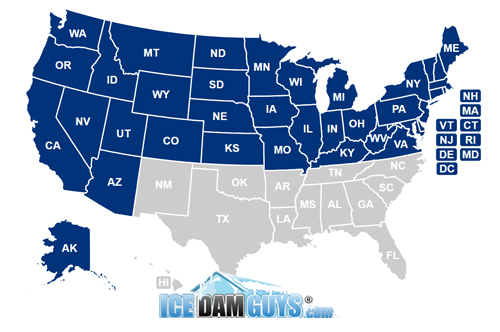How to Winter-Proof Your Roof
Many homeowners wrongly assume that they can stop worrying or thinking about their roofing when winter rolls around. Most people associate roof leaks with rain, not with snow. There generally aren’t any major windstorms during winter to blow branches into the roof or to rip shingles off, gutters aren’t getting clogged, etc. As far as most people are concerned, winter is a great time to put their feet up, rest by the fire, and stop worrying about home maintenance and repairs. All your chores are covered in snow, right?
If only that were true. Your roof is more at risk during a winter of hefty snow than it is during the summer.
Snow melts and refreezes, causing ice dams, which in turn can cost tens of thousands of dollars in water damage. If you want to keep yourself and your family warm and dry during the winter season, you need to take some precautions.
Buy a roof rake, and use it!
Because the greatest threat to your roof is the accumulated snow, and the shortest path to safety is to get the snow off of your roof. Though you don’t have to go crazy every time there are flurries, you should aim to at least start roof-raking after every six inches or so of accumulation.
Note I said accumulation, not snowfall. If you’ve got a two-inch snowfall, a three-inch snowfall, and a four-inch snowfall, then you’ve got 9 inches of snow on your roof. Don’t think that you’re safe just because “there was only two inches of snow last night.” Keep track, even if you have to mark the snowfalls on a calendar. Although, just simply keeping an eye on the thickness of snow visible from the ground should be adequate.
If you’re only worried about roof collapses – and not so much about ice dams – you can wait even longer. In that case, you could quite easily allow the snow to pile up to more than a foot before even thinking about busting out your trusty roof rake. But remember, the deeper the snow is, the harder it is to rake from your roof.
Upgrade the “R” value of your home’s insulation.
One of the biggest reasons people get ice dams is that warm air has escaped through the attic (from the warmed living space below). This loss of heat into the attic space raises the temperature of the underside of your roof until the snow becomes water and begins to slowly trickle down the slope of your roof. When the water hits the cold overhangs (not warmed by any living space beneath them) it re-freezes, and an ice dam is beginning to take shape. As more snow melts, that water gets trapped behind the ever-growing ice dam. That’s just as bad as any hard rainstorm hitting your roof. In fact, it’s worse, because the pool of water (melted snow) just sits there until it’s able to work its way under the shingles. Remember, a shingled roof is designed to shed water, not hold it.
Insulation is meant to minimize heat loss from a living space. Insulation is measured by its “R” value. The “R” stands for “resistance,” and measures how well the material resists heat. For example, The Department of Energy and the Council of American Building Officials recommend an R-value of 49 or above for Minnesota residents. But…you don’t have to do the bare minimum, and in fact in most cases you shouldn’t. If your R-value is already at 49 and you are still getting ice dams, you might consider upping to an R-60 level of insulation instead.
Sounds daunting and expensive, but it typically pays for itself (plus some). You’ll save on potentially costly repairs due to roof leaks caused by ice dams. You’ll save money on ice dam removal. You’ll also save money on your home energy bill, because it won’t cost as much to heat your home. (See: How Much Insulation Is Needed to Prevent Ice Dams?)
Update Your Ventilation
Some roofs get into trouble because they simply don’t have adequate ventilation in their attic space (or whatever area exists between your roof deck and the living space beneath it). Good attic ventilation allows any warm air that gets expelled into your attic to pass harmlessly outside, through the vents, instead of getting trapped and collecting under the roof deck. Homes that do have adequate ventilation are much less susceptible to ice dams, although they can in fact still get ice dams, simply because the vents get blocked by snow – especially by heavy, wet snow. Yet another great reason to keep your roof an free from snow as possible.
You will need to meet with a professional roofer, preferably during the warmer months, to determine how good your ventilation is. If you’ve never had anyone work on your roof before – like because you bought the house recently, or just haven’t had any problems in the past – then it’s impossible for you to know for sure without a consultation.
Make the ceilings and the walls as airtight as possible.
Did you know that there are many places in your home where hot air can pass right into the attic, unrestricted? Well, there is. And all the insulation in the world won’t help you if it’s being completely bypassed.
Let’s take your average living room as an example. Let’s say you’ve cranked your heat up to 75 degrees and your living room is nice and toasty. You may feel like all that heat is just sitting there with you while you’re watching television. But it isn’t: some of it is escaping through your insulation (no matter how good it may be), and some of it (maybe even a lot of it) is escaping through what we in the industry call “attic bypasses.”
An attic bypass is literally any penetration through your walls and ceilings, and you’ve got more than you think. Every outlet, light fixture, exhaust fan, smoke alarm, light switch, and so on, is a potential bypass. Hot air seeps through these tiny cracks and rises straight up into your attic, potentially bypassing some or all of your insulation. Getting these bypasses taken care of is typically not very expensive, and it can save you from having to deal with expensive ice dam removal and/or the damage to your home ice dams can cause.
The ultimate goal is for the attic to remain at the same temperature as the air outside (i.e. the ambient temperature). Tossing a quick thermometer in your attic, and comparing it to the ambient temperature is a great quick & easy way to find out how much (or little) help you may need.
Check your exhaust stacks.
Do you know where the exhaust stack from your stove is going? How about your bathroom fan? These are just a few types of common exhaust fans found in most homes.
Many times that hot air is venting out directly into your attic, which is exactly where you don’t want it to go. That’s one of the most common reasons for a warm attic (and ice dams) that we see. Find yourself a good contractor to extend these exhaust stacks all the way through the roof. Better yet, ask them to insulate the stacks where they pass through your attic space. Also, make sure they keep the exhaust outlets away from your soffits for maximum protection. The closer towards the peak of your roof, the better. (See my post, “Another Reason to Get Ice Dams Removed: They Can Block Your Exhaust.”)
Have a roofer install ice and water shielding the next time you replace your roof.
Most roofers only install a few feet of ice and water shielding on homes. They typically try to cover the “trouble spots” (e.g. the overhangs). But as long as your roof has sufficient ventilation, there is no rule that says you can’t install ice and water shielding on your entire roof. In fact “I” wouldn’t even consider redoing my roof without first covering the entire roof with ice & water shield.
If you do that, your only likely concerns in winter will be keeping the weight of snow and ice off the roof. You might get ice dams, but the ice and water shielding will almost certainly keep the water out of your home. Because you will never (or almost never) experience a leak, you can enjoy the football game while other people are out scrambling around trying to find an ice dam removal professional to take care of the water pouring into their homes.
You may have to negotiate with your roofer a bit to make that happen. For tips on how, see “Stop or Minimize Your Leaks with a New Roof.”
Stay proactive, stay on top of it, and keep thinking about it.
If you want to put your feet up in the winter, you can—and should—address most of these issues during the warmer months. It’s not ideal to install ice and water shield on your roof in the dead of winter, for example. More home energy audits take place in the summer as well, and if you haven’t bought your roof rake by mid-November you’re out of luck, because every store will be sold out. Make sure you’re thinking about roof protection during all four seasons of the year.






















